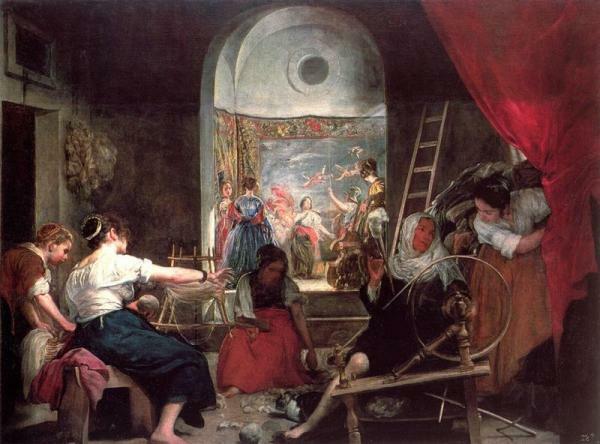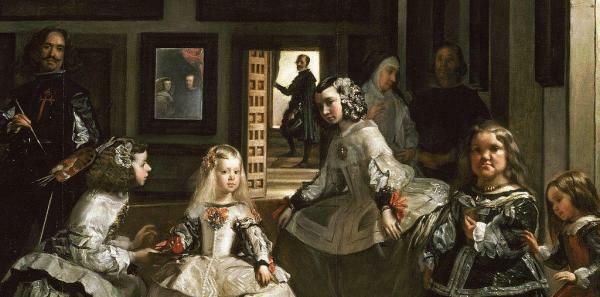Baroque art in Spain

Image: In Art Class - Wikispaces
The baroque in Spain will be characterized ideologically by the problems produced by the opposition between Europe Protestant and Catholic Europe, hence the baroque is sometimes also known as the art of Counter Reformation. Chronologically we are among the 17th and 18th centuries, historical period corresponding to the reign of the House of the Habsburgs and already in the 18th century to the consolidation of the Bourbon dynasty. Next, in this lesson from a TEACHER, we will see why it was characterized baroque art in Spain with the most prominent examples taking into account that it was an art generally promoted by the Church and royalty.
Index
- Baroque architecture in Spain
- Examples of Baroque architecture in Spain
- Baroque sculpture in Spain
- Examples of Baroque sculpture in Spain
- Baroque painting in Spain
- Examples of Spanish Baroque painting
Baroque architecture in Spain.
We start with this summary of baroque art in Spain
speaking of architecture. When talking about it, we have to mention the chronology, because they are going to be distinguished three stages:- From 1640 to 1680: we will see what is known as "baroque nude”Of Herrerian influence, characterized by the austerity and sobriety of the forms, being Madrid its main focus.
- From 1680 to 1720: the need to show the sumptuousness on the part of the ruling classes, caused many buildings to be covered with lush ornamentation and is what is known as "flowery baroque"Or"churrigueresque baroque”.
- From 1720 to 1770: is the period rococo, considered as the last phase of the Baroque, characterized by the accumulation of decoration, its focus being Galicia.
Baroque architecture will be closely linked to urbanism, in this way palaces, gardens, churches are going to be decorated externally to attract the attention of the public, abandoning completely defined and straight lines typical of the Renaissance by the curves giving a feeling of dynamism to the edifice.
In general, in architectural constructions we will see the introduction of a novelty based on plants, since now they prefer a circular, mixtilinear, elliptical... with plaster domes supported by wooden frames and with interiors where the architectural lines will disappear due to the abundant decoration that there will be on the cornices, columns, capitals... being the altarpieces, which will be large and will appear gilded and painted, which among other things monopolize all the looks.
Over time, the decoration will continue to be reflected not only inside buildings but also outside where the facades will be covered with new elements that will give it movement, with the appearance of the Solomonic columns.
In this other lesson we will discover the general characteristics of baroque art.

Image: ARtEydiBujo
Examples of Baroque architecture in Spain.
One of the most outstanding examples based on civil architecture is going to be the Plaza Mayor of Salamanca designed by the Churriguera brothers Like the one in Madrid, it has a closed layout, with porticoes at the bottom and houses on the rest of the floors. The beautiful decoration with those polychrome effects given by the use of stone and granite, the wrought iron balconies and topped with that balustrade of pinnacles in the shape of the fleur de lis make this one of the most beautiful squares in the entire peninsula.
Another characteristic example of Baroque architecture is the Madrid's royal palace commissioned to be built by Felipe V, being the work of the architects Juvara,Sachetti Y Bonavia. It was built as it was a palace for royalty with noble materials, such as marble and its construction comes to symbolize the exaltation of the Bourbon dynasty in Spain.
To cite other examples, we have in Seville other clear exponents of the Baroque, such as the Capilla of St. Louis of the French and in Galicia the Obradoiro facade in the Cathedral of Santiago de Compostela, built to protect the Pórtico de la Gloria.
Baroque sculpture in Spain.
We continue with this summary of Baroque art in Spain to focus, now, on the sculpture of that period. This is the quintessential era of Spanish imaginary, conceived to be exhibited and accentuate a closer contact with the faithful, so that the thematic will be exclusively religious, profane and mythological sculpture is going to be practically non-existent.
In addition, the church was the main patron, thus in one way or another to combat the spread of Protestantism. The appearance of brotherhoods were those that promoted the art of the altarpieces where they were narrated mainly scenes from the Old Testament, the Virgin, the Passion of Christ, the bulk sculptures round and the processional steps of Holy Week, which were characterized by being natural, dramatic and emotional statures.
The material used par excellence will be the polychrome wood and to a lesser extent you will see carvings of stone, alabaster, ivory or marble. Sometimes many of the wood carvings to make them a more real effect in terms of clothing, the stew technique, which consisted of covering the wood with sheets of gold leaf, to later add a layer of paint, once dried it was scraped so that the final result was the gold that appeared underneath, thus imitating sumptuous clothing.

Image: Social Science Class - WordPress.com
Examples of baroque sculpture in Spain.
Spanish Baroque sculpture can be focused on two main focuses: Castile and Andalusia.
Baroque sculpture in Castilla
The main characteristics that are going to be given are verismo, a taste for drama, matte and flat colors, without stews… quite the opposite of what we will see in the Andalusian focus. Here the works in general tend to be sadder, sober and serious.
The master imaginer par excellence is Gregorio Fernandez that he spent most of his life in the city of Valladolid, his works are characterized by sobriety and by expressing expressions through his hands and faces. His work is very broad, although we have to highlight his Christ tied to the column and the Reclining Christ, the latter of great anatomical perfection and without any idealization.
Baroque sculpture in Andalusia
Despite the fact that this century is going through an economic crisis, it will be favored by the traffic of American trade and although linked to the Renaissance tradition, artists soon abandoned Renaissance classicism in search of greater veracity and realism.
In the Andalusian area, the images won't be as dramatic, that is to say, violence will be avoided at all times to give priority to beauty, sweetness, it is a sculpture therefore more friendly and calm. The colors will be more vivid and will make more use of the braising technique.
In the city of Seville, the figure of Martinez Montanes, always working with the religious theme of calm and serene content, he was also the creator of iconographic typologies of Christ and the Immaculate, being the best example of him the Christ of Clemency and the Immaculate of the Cathedral of Seville.
Another great sculptor is Juan de Mesa, considered as the great sculptor of processional images, which are characterized by being very expressive and transmitting a great feeling. Some of his most important works are Jesús del Gran Poder, the Virgen del Valle and the Cristo de la Buena Muerte belonging to the Brotherhood of Students of Seville.
Baroque painting in Spain.
And to finish with this summary of Baroque art in Spain, we are now going to focus on pictorial art. In painting it is what is known as the Spanish Golden Age for the high quality of the pictorial realizations, giving rise to the most important artists of all time.
The main clients of Baroque painting were the court, the church and the aristocracy, an art that also was subject to the surveillance of the Holy Inquisition, hence the scarcity at this time of genre painting or mythological. Regarding the characteristics, it has some common features that are:
- Theme: mainly religious, although we will also see some portraits and some mythological themes; the still life will be another of the themes of great simplicity.
- Composition: Spanish painters were characterized by not showing much interest in composition, except for Velázquez and Ribera, so most of these will be juxtaposed compositions.
- The light: At first, the artists were characterized by that tenebrism influenced by Caravaggio, sometimes taking the figures a certain sculptural precision, which is what happens with Zurbarán. As time goes by, artists become interested in creating a type of atmosphere, reaching great aerial perspectives.
- The iconological scope: embodied in his works through allegories, hieroglyphs, symbols, to give the paintings a narrative character, a reading that will be a true program of persuasion.

Examples of Spanish Baroque painting.
Among the most important artists of the Spanish Baroque we have to highlight Zurbarán, who was an Extremaduran painter who worked a lot for Seville and whose works were full of simplicity, within the orbit of the tenebrism, dealing mainly with religious themes, although it will also have themes on still lifes or also known as still lifes.
With his works he always tried to move from repose and simplicity. Some of the most outstanding works of him are The miracle of Saint Hugo in the Carthusian refectory and the religious group of Holy martyrs.
Murillo is another of the notable figures of this golden age. His main client was the church, hence most of the works are religious in nature. Some of his most famous works are the Immaculate Conception and the numerous works in which the children's theme is present, such as Children eating grape and melon, children of the shell…
And we close this block with the figure of Diego Velazquez, another Sevillian painter who developed much of his activity in Madrid since he was the chamber painter of Felipe IV and whose The most outstanding pictorial characteristics in his painting were reaching a greater degree of depth in his works through the aerial perspectives.
Among his most famous works, mention some of his first Sevillian period, such as the Old woman frying eggs, from the Madrid stage the Surrender of Breda and already of his latest works Las MeninasThese last two are exhibited in the Prado Museum in Madrid.
If you want to read more articles similar to Baroque art in Spain - Summary, we recommend that you enter our category of Story.



